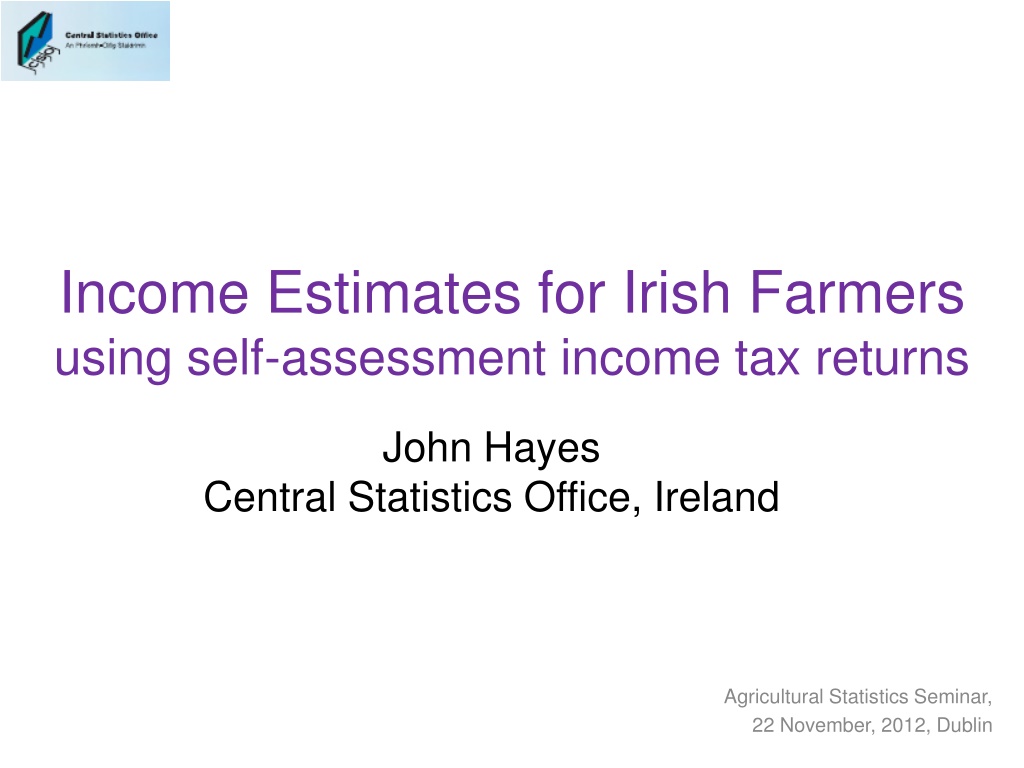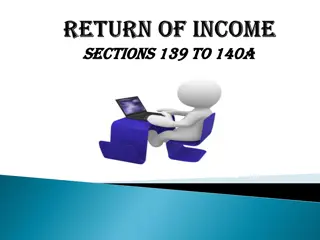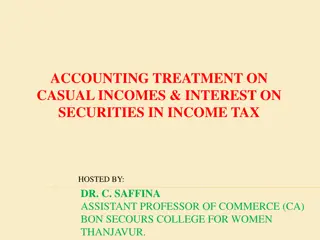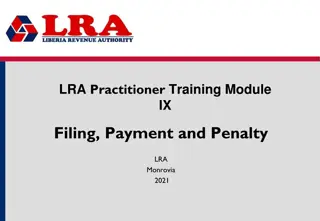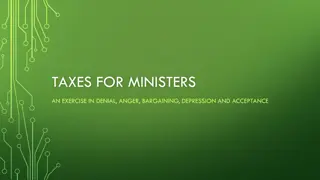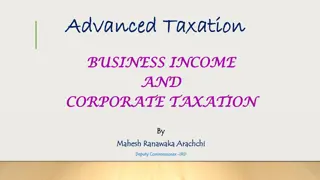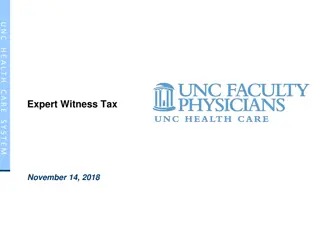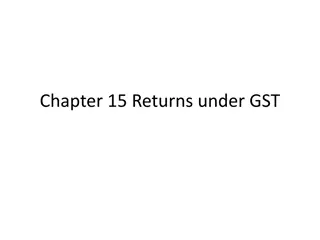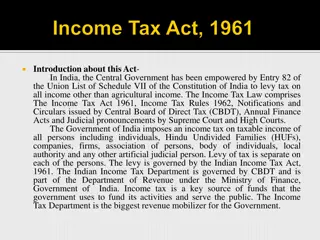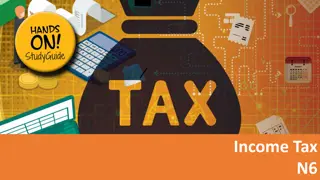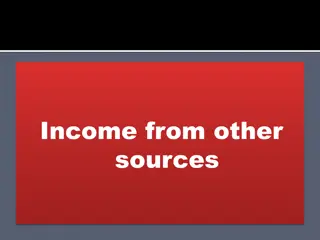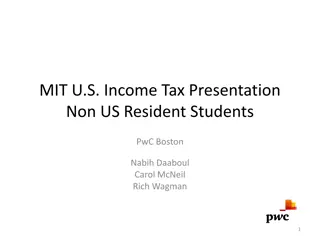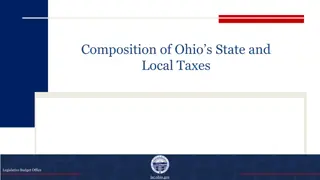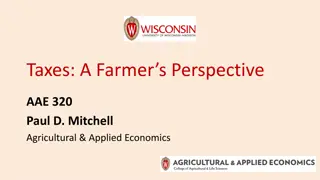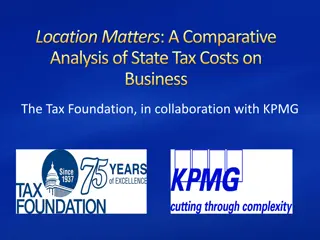Analysis of Irish Farmer Incomes Based on Income Tax Returns
This paper presents an analysis of Irish farmer incomes in 2010 using self-assessment income tax returns from the Revenue Commissioners. The study focused on various income sources such as trading income, rental income, employment income, social welfare transfers, and pension income. The dataset comprised 81,143 farmer filers, with a detailed examination of Form 11 returns to determine relative incomes between Disadvantaged Areas and non-Disadvantaged Areas. Key definitions and notes related to farmers and income sources are also provided.
Download Presentation

Please find below an Image/Link to download the presentation.
The content on the website is provided AS IS for your information and personal use only. It may not be sold, licensed, or shared on other websites without obtaining consent from the author. Download presentation by click this link. If you encounter any issues during the download, it is possible that the publisher has removed the file from their server.
E N D
Presentation Transcript
Income Estimates for Irish Farmers using self-assessment income tax returns John Hayes Central Statistics Office, Ireland Agricultural Statistics Seminar, 22 November, 2012, Dublin
Introduction This paper details an analysis of Irish farmer incomes in 2010, conducted by the Central Statistics Office (CSO) using self-assessment income tax returns to the Revenue Commissioners. 2
Project initiation The primary provider of administrative data for statistical purposes to the CSO is the Office of the Revenue Commissioners (Revenue). Amongst the data holdings supplied is Income Tax Form 11 returns, the annual tax return of persons chargeable under self-assessment (in the main, self-employed persons). The CSO was approached by the Department of Agriculture, Food and the Marine (DAFM) to investigate whether income tax filings could be used to obtain information on the relative incomes of farmers in Disadvantaged Areas and non- Disadvantaged Areas. The analysis focussed on reference year 2010, and on the following components of the Form 11 return: trading income, rental income, income from employment, social welfare transfers, and pension income. 3
The analysis dataset The analysis dataset was 81,143 farmer filers. Of this number, 75,646 filers had identified themselves as farmers on the Form 11 return, while another 5,497 Form 11 filers were identified as farmers from the DAFM list. Note that the size of the analysis dataset reflects the fact that the analysis was performed on the earliest version of the Form 11 data holding received for reference year 2010. Note also that many farmers deriving a low income from farming are not required to make Form 11 returns, as, with the agreement of Revenue, their PAYE credits (for example) are instead decreased to reflect the taxable element of farm income. 4
Some definitions/notes Farmer: For the purposes of this paper, a farmer is any Form 11 filer (i) who identified himself or herself as a farmer on the Form 11 return, or (ii) whose Personal Public Service Number (PPSN) was on a list of farmer PPSNs provided by the DAFM Disadvantaged Area: A Disadvantaged Area is a townland designated as one in which the ability to farm is restricted by the physical environment. Income from Trade: Filers are allowed to make returns for up to three separate trades on the Form 11. The term Income from trade, as used in this paper, means income before any deductions for intermediate consumption or other expenses/inputs. It represents the combined, gross income from all types of trading activity, not just farming. Assessable profit: the amount on which the filer is assessable for tax. Only the taxable element of social welfare benefits is to be entered on the Form 11. Thus, Back to Work Allowance, Jobseekers Allowance, and Maternity Benefit, which are all exempt from income tax, should not be entered in the Form 11 return. 7
Relative importance of each component of income, and income differences between non-Disadvantaged and Disadvantaged Areas Table 1 2010 Income Tax Farmer filer gross income, by non-Disadvantaged Areas and Disadvantaged Areas, Means non- Disadvantaged Areas, Disadvantaged Areas, Component State, Income from trade 80,092 70,201 73,959 Gross rent receivable 6,517 3,173 4,444 Income from employment in Ireland 20,829 20,615 20,696 Taxable social welfare payments 4,017 3,707 3,825 Irish pensions (non-social welfare) 1,964 1,236 1,513 Summed Income 113,418 98,933 104,436 Income from trade accounts for almost 71% of Summed Income at state level. Income from trade in non-Disadvantaged Areas was 14% higher than that for Disadvantaged Areas. Income from employment in Ireland, which is almost 20% of Summed Income, is relatively more important in Disadvantaged Areas (almost 21% of Summed Income) than in non-Disadvantaged Areas (over 18% of Summed Income). Summed Income of farmer filers in non-Disadvantaged Areas was almost 15% more than that of those in Disadvantaged Areas. 8
Income, profit from farm trade, by non-Disadvantaged Areas and Disadvantaged Areas Table 2 2010 Income Tax Farmer filer gross income and profit categories, by non-Disadvantaged Areas and Disadvantaged Areas, Means non- Disadvantaged Areas, Disadvantaged Areas, Component State, Income from farm trade 63,981 54,719 58,238 Income from other sources 49,438 44,214 46,198 Assessable profit from trade 22,493 16,925 19,040 Assessable profit from farm trade 16,979 12,936 14,472 Assessable profit from non-farm trade 5,514 3,989 4,568 Income from farm trade of farmer filers accounted for almost 79% of income from all trades (see Table 1). The income from farm trade of farmers in non-Disadvantaged Areas was almost 17% higher than that of farmers in Disadvantaged Areas. Assessable profit from all trades was almost 33% higher in non-Disadvantaged Areas; in terms of farm trade alone, profit for farmers in non-Disadvantaged Areas was more than 31% higher than for Disadvantaged Areas. 9
Summed Income quintile analysis, State level Table 3 2010 Income Tax Farmer filer gross income, by summed income quintile group, Means 1st Quintile < 37787, 2nd Quintile < 61277, 3rd Quintile < 89879, 4th Quintile < 142654, 5th Quintile 142654, Component State, Income from trade 12,372 26,837 41,857 72,725 215,996 73,959 Gross rent receivable 1,267 1,676 2,308 3,963 13,004 4,444 Income from employment in Ireland 4,347 13,824 24,596 31,407 29,307 20,696 Taxable social welfare payments 4,762 5,506 4,000 2,734 2,123 3,825 Irish pensions (non-social welfare) 602 1,550 2,014 1,791 1,606 1,513 Summed Income 23,350 49,393 74,774 112,621 262,036 104,436 Summed income for the lowest quintile of farmer filers in Ireland was over 22% of the State average and just 9% of summed income in the highest quintile. In terms of income from trade, the disparity between lowest and highest quintiles is greater, with the lowest quintile figure being less than 6% of that for the highest quintile. 10
Marital characteristics, by non-Disadvantaged Areas and Disadvantaged Areas Table 4 2010 Income Tax Farmer filings, marital characteristics, by non-Disadvantaged Areas and Disadvantaged Areas non- Disadvantaged Areas, % Disadvantaged Areas, % Component State, % Percentage of filers who are single 20.4 23.2 22.1 Percentage of filers who are married 71.6 70.9 71.2 Percentage of filers with other marital status 8.1 5.9 6.7 Percentage of filings showing spousal income from farming 6.5 4.3 5.1 Percentage of filings showing spousal income from any source 52.5 52.3 52.4 Over 22% of income tax farmer filers for 2010 were unmarried. The percentage of farmer filings showing spousal income was over 52%; however, only 5% of filings showed spousal income from farming. 11
Conclusions As many farmers deriving a low income from farming are not required to make Form 11 returns, more weight should be attached to componential comparisons than to the absolute figures produced. The analysis shows that there is a significant difference in farmer incomes between non-Disadvantaged Areas and Disadvantaged Areas. The analysis also shows a wide disparity in incomes between farmers in the lowest income quintile and those in the highest income quintile. A corroboration exercise was conducted using reference year 2009, which produced similar results for absolute income levels and componential breakdowns. However, the two years are not directly comparable because of changes in the content of Form 11 from one year to the next. 12
